
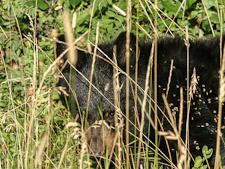
A few months earlier as a starving cub, the bear had been taken to the Espanola-based veterinarian by an officer of the New Mexico Department of Game and Fish (NMDGF). The tranquilizing dart he shot at it had shattered the bear’s shoulder and embedded into her third rib. “Doc” Ramsay, he knew, would take care of the wild creature, just as she had done for other large predators over the past 10 years. The little bear would be only one of many in the coming months. During the drought and fire-stricken spring, summer and fall of 2011, Ramsay housed, fed and rehabilitated as many as 33 bears at a time. They were kept in a fenced-off, hidden location, far from curious visitors of the human species.
Most of the bears brought to Ramsay were orphaned cubs, but there were a few older animals. Despite looking appealingly cute, Ramsay warned that even a 15-pound cub “could tear your face off” if cornered. They were all black bears (Ursus americanus), ranging in color from cinnamon to dark chocolate. In the crowded pens, some of the cubs played or sprawled in the sun. Others hid or pawed at the wire frames to try to break free. A one-year-old male paced in his pen, letting us know his discomfort, wailing like an unhappy wind. Our small group had been invited to attend the darting, transport and release of five of these rehabilitated bears to a new location. This was the only time Ramsay permitted people to visit; in fact, she preferred a mob. Our job was to help scare the animals and make sure they associated people with being terrified.
While Kerry Mower, a wildlife heath specialist with the NMDGF, was tranquilizing another bear, Ramsay ordered some of the young men standing around to pick up the limp cub and put her in the cylindrical cage towed by the agency’s truck. “I’m not doing it,” Ramsay said, touching her back where a titanium rod ran along her once-shattered spine. A second later, she grabbed two of the animal’s legs and helped move her into the cage. Ramsay couldn’t stay still. She needed to be doing something.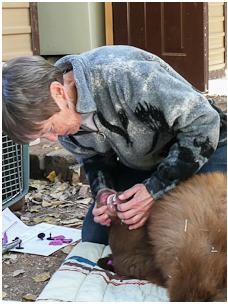
Her hair cut short to be out of the way, and the thin 50-ish woman’s body twanged like a snapping rubber band. Ramsay was constantly in motion, only pausing for a few moments for a comment or to let a smile seep into the lines crinkling around her clear blue eyes. This was her passion. It has been for 30 years.
She was barely out of school and working as a new assistant veterinarian in a clinic when a golden eagle was brought in. The bird’s wing was broken, and it flailed desperately against the chains of a foothold trap. Ramsay took one look at it and knew, “If I did anything with my life, it would be to work with wild animals.” In 1986, in addition to her domestic animal veterinary practice, she set up the nonprofit Wildlife Center in Espanola for citizen education and animal rehabilitation, mostly working with small mammals and birds. Fifteen years later, Mower and other game officers started bringing injured bears to Ramsay.
As the iconic state animal of New Mexico, the black bear is a potent symbol of both the best and worst of human and wild animal interactions. Although the black bear is not an endangered species, the fluctuating bear hunting quotas set by the governor-appointed State Game Commission, based on population estimates by the NMDGF, generate a lot of controversy. Last year, the Commission set the hunting take 30 percent higher than the previous year. They believed that there were too many of the large predators, especially at the urban/forest interface. These new numbers reflected the increasing number of bears killed or captured and relocated through the depredations program used to solve human/wildlife conflicts on private property, as well as accidental mortalities such as road kill and other reported incidents. There was an outcry by animal protectionists who felt that allowing so many animals to be hunted, especially the sows, would lead to a substantially reduced population.
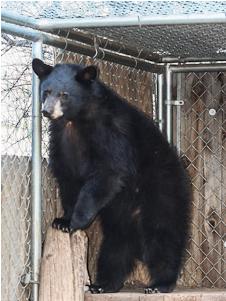
By mid-summer, the New Mexico sky was filled with nature’s rage, as hundreds of thousands of forested acres burned across the state. Most devastating was the Los Conchas fire, which evacuated the town of Los Alamos, igniting an unheard of 48,000 acres of dry ponderosa pine forest in a single day, uncontrollably cresting down to the Santa Clara and Cochiti Pueblo lands. The sky was black, and the air in nearby towns was unbreathable from the ash and smoke.
Range livestock were killed in the fire, homes burned and wild animals found as charred corpses amid the smoldering debris. The game officers had to put down some animals that were too badly burned to survive. One bear was reported by the firefighters, who found it walking on its knees with its feet turned over. It was easily captured by the NMDGF, who then brought it to Ramsay.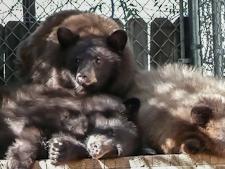
Bernadette the bear became a media darling overnight, as Ramsay scraped away the seared skin, put burn packs on her feet and changed the dressings repeatedly. The bear started to recover and began walking tenderly again. Television crews and journalists seized on Bernadette’s recovery as one hopeful outcome from the terrible destruction. After three weeks, the bear’s health began to decline. Ramsay saw the animal hobbling again, relapsing into pain. She could no longer walk on her front feet.
I spoke with Ramsay the evening before the bear was euthanized. Ramsay told me, choking with emotion, “I cannot justify making her suffer, just because I want something hopeful to come from the fire.”
Calls about nuisance animals desperate to find food continued to bombard the game officers. As a far-too-common example of depredation, James Martinez, a NMDGF officer in Chama, told the story of a sow with two cubs that visited a porch where a family had left a dirty grill overnight and wouldn’t leave. The charcoal soaked with fat drippings was a feast to the starving animals. The homeowners called NMDGF to take care of the problem. Martinez said he had to shoot the sow, but felt very bad about it, considering it was the landowner’s fault, not the bear’s. He brought the cubs to “Doc.”
Ramsay doesn’t get involved in the debates over population densities and the appropriate quotas for bear hunts; she is too busy with the animals that end up in her care. She does have strong feelings about homeowners living in proximity to wildlife habitat who do not take responsibility for keeping the environment safe for its original inhabitants.
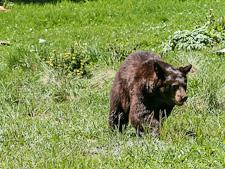
The bears are doing nothing else than what nature ingrained in them, Ramsay said. Historically, bears followed the natural corridors leading from their mountain homes, down arroyos and canyons to the rivers that guaranteed the fruit and forests they depend on, especially during a drought season. Now with people moving closer to the mountains and forests, the sad exchange is the loss of available habitat for the animals that live there. As the land gets chopped up, the animals cannot comprehend that it is no longer their territory and often pay the price. The number of depredation calls to NMDGF ending in the death or relocation of an animal would be lessened if people learned how to better coexist with nature.
Biophilia is a term invented by Erich Fromm in 1964 and brought into common language by Harvard biologist and writer E.O. Wilson a few decades later. It describes the instinctive tendency humans have to affiliate with other animal species. For many people this connection may be owning a pet or putting out bird feeders. For Ramsay and others who have dedicated their lives to animals, it takes the form of a rare and extraordinary sense of responsibility to help the wild victims of a human-altered world.
Ramsay wakes up every morning at 4:30 a.m., travels to the holding area and spends the next four hours cleaning out the bears’ pens before heading off to a full day at her regular veterinary practice. She has performed long surgeries on injured animals such as the star bear, been scratched and threatened by the frightened tenants of her holding pens, nursed malnourished animals back to fattened health, treated burns and bites and wounds, fallen out of a tree and burst her spine trying to reach for a bobcat, and is on call 24/7 to help with wild animals all over New Mexico. She is not paid for any of this work.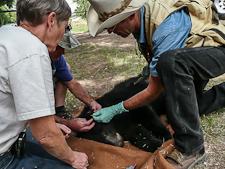
Mower – the lanky, white-cowboy-hat-wearing, soft-spoken NMDGF officer who has worked with Ramsay for more than a decade – said that at first, the Game and Fish officers were dubious about bringing large predators to Ramsay. They weren’t sure she could handle the unruly animals and also worried that she would not be able to euthanize them when it was necessary. Ramsay proved she could do both, and game wardens across the state have come to rely on her practical judgment and medical knowledge.
With a laugh, Mower shared a story that may have clinched his utter trust in Ramsay. Years ago, a nuisance mountain lion was collected by an officer and brought to Espanola for treatment. It had been transported for a long time in a bear trap, which had both a front and back door. As Ramsay climbed into the trap to evaluate the tranquilized animal, it roused. Mower was outside and saw the lion try to bolt for the open back door. His choice: let the animal loose in a developed area or shut the veterinarian in the bear trap with a peeved mountain lion. He did not hesitate. He slammed the door. Ramsay, he said, threw the towel she was holding over the lion’s head to momentarily blind it, just as Mower threw the keys to the other door to his assistant. A minute later, Ramsay exited the front, not at all flustered by her close encounter with a mountain lion.
“She can read wild animals and knows the limits,” Mower said. “Predicting their reactions keeps her safe and others safe.”
Critics of NMDGF say the department would rather euthanize the nuisance animals, but that is clearly not true based on the number of bears that are rehabilitated and released. Before being relocated, the bears receive a noticeable tag in one of their ears. The tags have a number, which is recorded along with the date and location of their release. If the animal turns up again in close proximity to people and is reported, it is reclaimed and given one more chance. The third time the bear is reported as a nuisance, it must be euthanized.
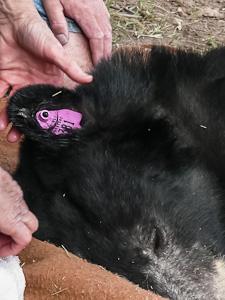
The bears that are diseased, injured, malnourished or otherwise incapable of surviving on their own are brought to Ramsay for rehabilitation. She has no romantic illusions about it. “Bears are not tidy animals,” she said, referring to the massive cleaning operation that goes on every morning. Last year, overcrowding was an issue, with up to six bears sharing a pen. Ramsay constantly shifted them around as new bears were added, doing her best to keep siblings together and match the ages of the cubs.
The housing pressure was relieved somewhat by a new pen purchased that fall through private donations, many of which also help support the costs of food and other expenses. Although the NMDGF brings Ramsay the injured and starving animals, they do not provide financial support. But local game officers will bring her road kill whenever they can to supplement the nutrient-rich stew Ramsay feeds the bears to fatten them up before release. Road Kill Café, she calls it.
The bears to be released during my visit were fat and healthy, all tranquilized and stowed safely in the cages mounted on the NMDGF trucks. Three were slated for north-central New Mexico, and the other two were headed northwest to the Four Corners area. Some students from a nearby high school had joined us, talking excitedly, and a crew from a local television station filmed the scene. A tall man stood to the side, nodding as he watched the activities. His body trembled slightly as he clutched two trekking poles for balance. When I went over to meet him, he said he was Dr. Ramsay’s husband. I knew his father had recently passed away and offered my condolences. He shrugged and looked away. “That’s the way it is,” he said, and I thought he was tremendously stoic with his grief.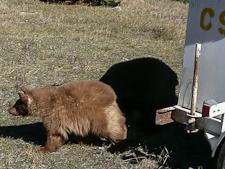
Lou Ramsay had been a large, healthy, robust and vastly intelligent man, capable at anything he did. Though he didn’t have a natural feeling for animals, he supported his wife’s work and made a point to be there for the releases. Mower filled in some of the details, as he had known Lou for years. One day, Lou abruptly quit his long career at Los Alamos Laboratories, though he was not far from retirement. It was a shock to his wife and did not make sense. Shortly after that, Lou started showing more erratic and out-of-character behavior. He would fall, finding it hard to keep his balance. His sharp mind lost its focus, and he became more and more childlike.
Lou was diagnosed with a rare neurodegenerative disorder called progressive supranuclear palsy, or PSP. It is often mistaken for Parkinson’s disease because of the muscular shaking and postural instability, but people with PSP do not respond to Parkinson’s treatments and protocols. The disease is progressive, leading to increased problems with balance, an inability to aim the eyes properly, and affective disorders including apathy, depression, emotional and personality changes and mild dementia. PSP damages parts of the brain. It gets worse with time, but does not kill, although it leads to difficulty in swallowing, choking, pneumonia, head injuries and fractures from falling. There is no cure.
Dr. Ramsay shared the ride with me up into the mountains for the release. The shadowed ruts of the dirt road slowed our drive, and Ramsay was intermittently quiet and then animated as she helped me negotiate the rocks and ice. She spoke of the tremendously difficult process of losing her husband to PSP. Used to fixing and doing and healing, Ramsay did everything she could to take on the illness, making the long drive to Denver on weekends to get experimental treatments for Lou and educating herself more fully about what to expect. The clinical trials at the Health Science Center had no impact, and Lou continued to decline. The worst part of the disease for Ramsay has been Lou’s loss of any real feelings, his inability to share with his wife any of the memories or joy or sadness of their life together. He is empty of emotion. The man she knew is gone.
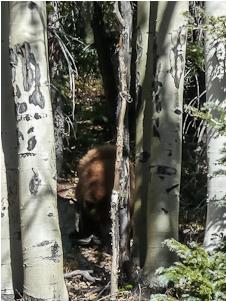
We parked at a turnout near an alpine meadow that was bordered by tall pines, the aspen and oak leaves making a golden understory while passing clouds and sudden sun lit them with cold fire. Ramsay leapt from the car, shouting orders to the young students to stand back or mount the trucks to be out of the way. We were about to see the bears released to their new lives.
Ramsay explained that relocation is not a magic solution for the bears. These youngsters aren’t familiar with the area and have to find food and water. They can be sitting ducks for the hungry, mature boars. The drugs used to sedate the bears have a 10 percent mortality rate, and some of the animals never wake up. But Ramsay has done her best to give the animals the skills they need to survive, as well as the repository of fat they will use over the winter. This year Ramsay’s bears will have that advantage over the malnourished animals who took dormancy after the brutal warmer seasons.
The cages were opened, and instead of the mad dash for freedom that I expected, the bears stepped tentatively onto the soft meadow grasses. One bear hid back in the cage, reluctant to leave. Ramsay instructed us to shout, which the students did with enthusiasm. The two bears took off as the hesitant one finally exited. We followed Ramsay as she chased the fleeing animals into the woods, shouting and clapping. The recalcitrant bear went in the opposite direction and had to be rounded up so that she would follow her companions.
For a moment, Ramsay leaned against the truck. “Bears,” she said. “I just think they are one of the most gorgeous creatures. I think all creatures are gorgeous.” A student gave a shout. One of the bears was lingering in the brush nearby. Ramsay took off in a flash, yelling and clapping as she chased the drug-woozy animal, making sure it headed well away from the road. She was fixing what she could.
Photos are copyright protected and may not be reproduced without permission. Copyright information for the images is as follows: 1) Black Bear, photo courtesy of Jonmikel and Kathryn Pardo; 3 and 5) Bear Enclosure and Bear Release, photos courtesy of Katharine Eagleson; all other images are courtesy of Zoe Krasney.